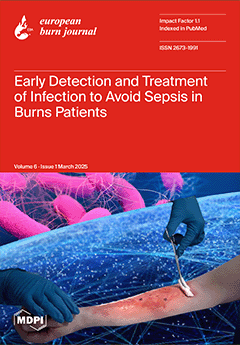Background: In 1994, the first Spanish study on patients with self-inflicted burns (SIB) was published, showing a prototypical profile of a patient with SIB: adult male, unmarried and, in 75% of the cases, with a psychiatric background. In addition, SIB accounted for 1.98%
[...] Read more.
Background: In 1994, the first Spanish study on patients with self-inflicted burns (SIB) was published, showing a prototypical profile of a patient with SIB: adult male, unmarried and, in 75% of the cases, with a psychiatric background. In addition, SIB accounted for 1.98% of the total admissions in a Burns Unit between 1983 and 1991, a lower percentage than other European studies. The present study aims to replicate this work, updating this profile and comparing it with the current profile. Methods: We compared the clinical and socio-demographic characteristics of 67 patients admitted during 1983–1991 (Study I) with those of 36 patients admitted during 2010–2015 (Study II). Results: It was observed that the percentage of patients with SIB admitted to the Burns Unit was lower in Study II than in Study I (1.45% vs. 1.98%). Significant age differences were identified (
t(101) = −2.074,
p = 0.041, 95% CI [−11.739, −0.261]). Similarly, there were statistically significant differences in several clinical characteristics, such as psychiatric history (X
2 = 11.591,
p = 0.001), the occurrence of previous autolytic attempts (X
2 = 7.714,
p = 0.007), the place where the incident occurred (X
2 = 11.647,
p = 0.020), the etiology of the burn (X
2 = 13.142,
p = 0.004), and triggers (X
2 = 6.420,
p = 0.036). Conclusions: Several differences have arisen between the two studies, mainly related to the specific characteristics of SIB (e.g., etiology, triggering cause, and place of the incident), possibly attributable to the social changes that have occurred in the last 20 years. These results will add to our knowledge and will stress various precipitating factors that may lead to SIB, with the final goal of designing preventive strategies.
Full article






